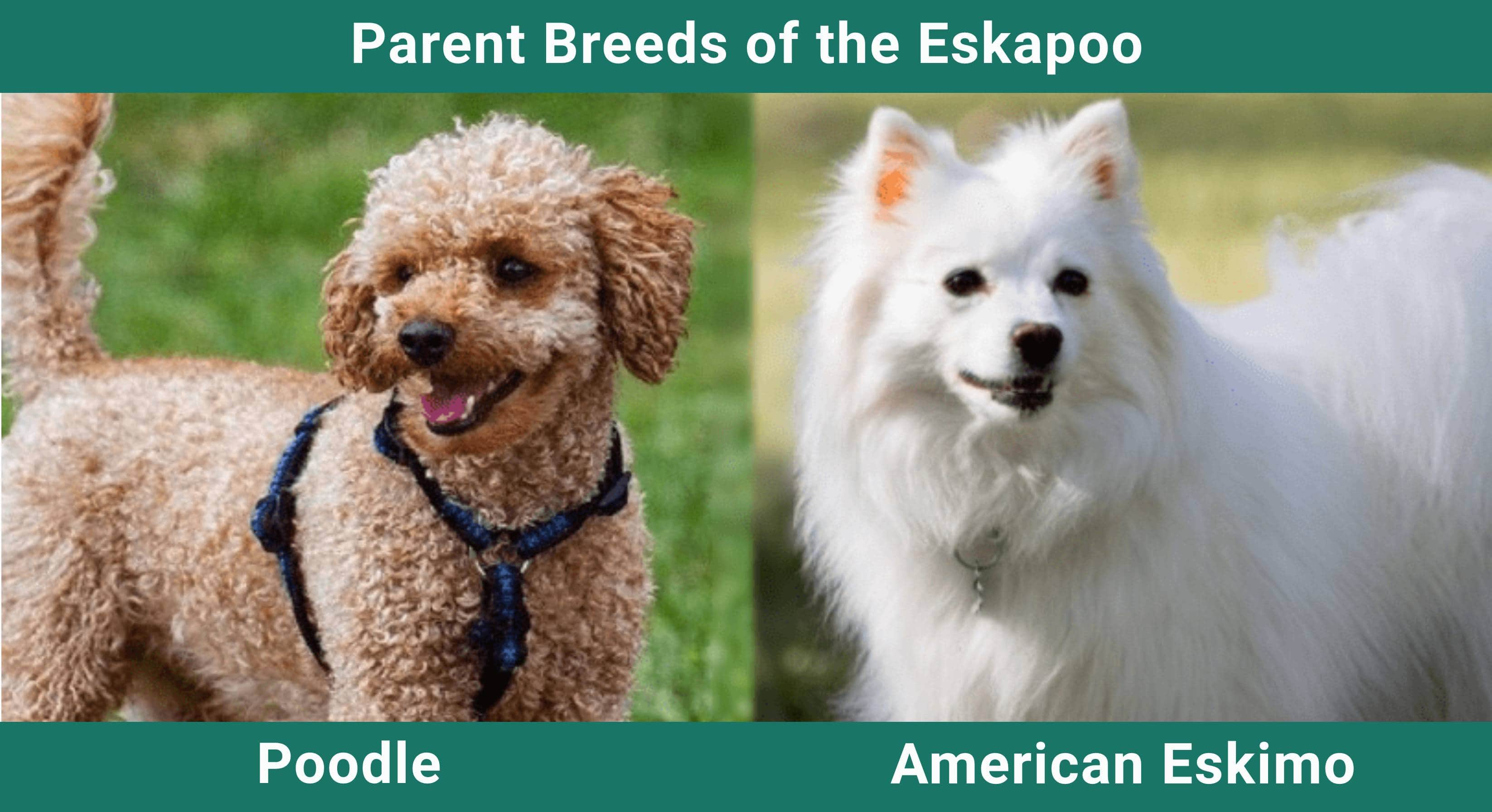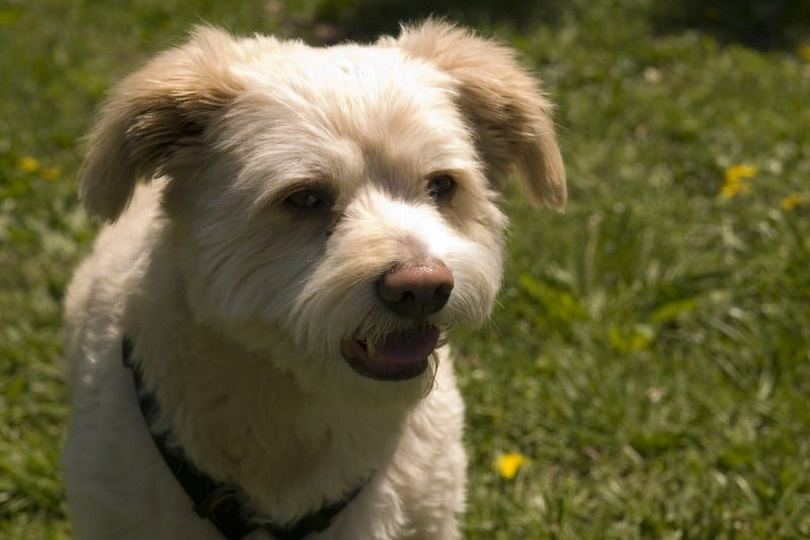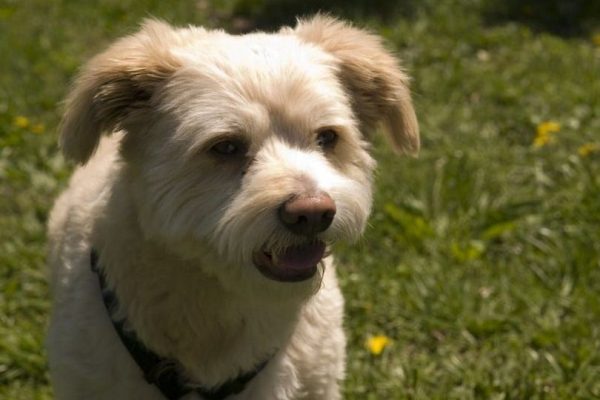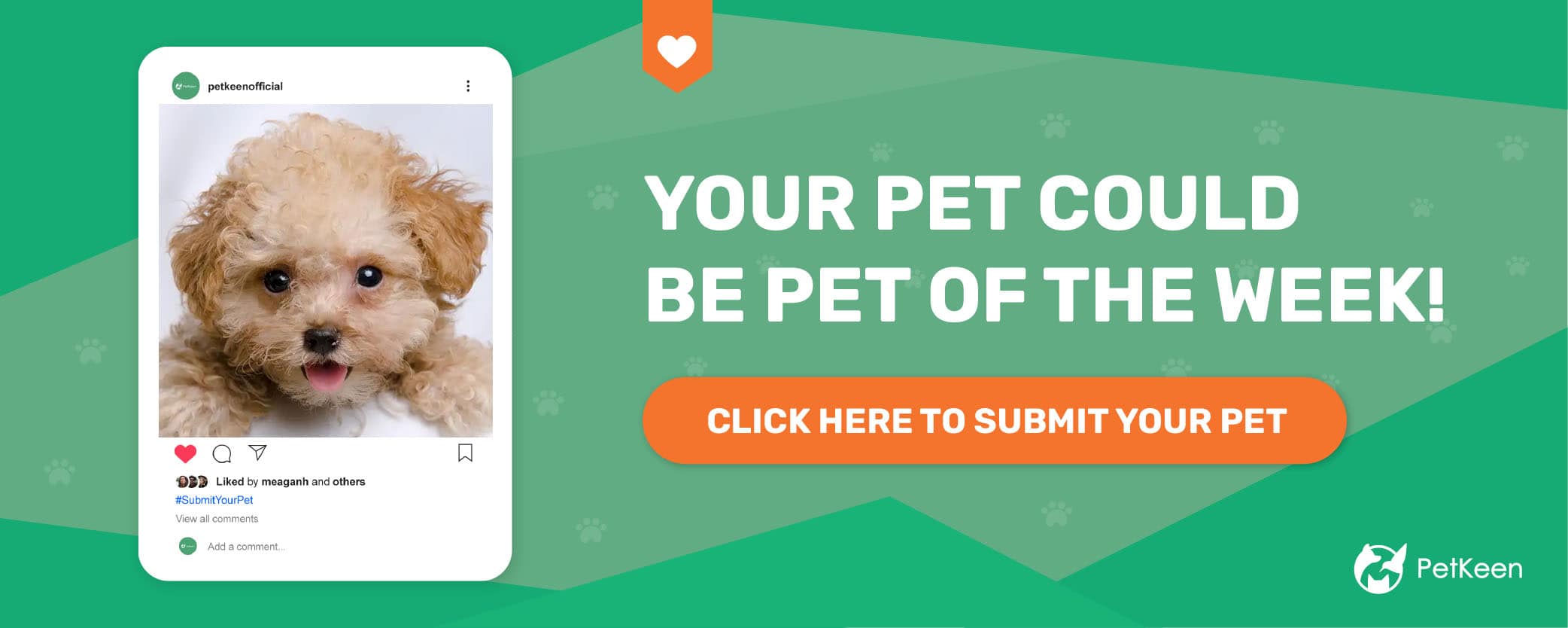Click Below to Skip Ahead
The Eskapoo is a mixed breed with a Poodle and American Eskimo parent. They are not the most popular Poodle-mix out there. However, they are increasing in popularity as mixed breeds become more common. Many dog-lovers are beginning to realize that the dog-world extends beyond purebreds, leading to an increase in the popularity of hybrids – including the Eskapoo.
Breed Overview
Height:
15 – 18 inches
Weight:
15 – 20 pound
Lifespan:
10 – 13 years
Colors:
Tans, Browns, Black, Merle
Suitable for:
Active families of all sorts; adaptable to apartments
Temperament:
Intelligent, Playful, Affectionate
The Eskapoo inherits traits from both of their parents. This means that you don’t know what you’ll end up with when you adopt a member of this breed. You could have a dog that is very similar to a Poodle or nothing like one. They are usually medium-sized dogs, but their weight can vary widely. Most are the descendants of a Toy Poodle, but other types of Poodles can also be used.
These dogs are pretty intelligent, which often makes them easy to train. They are active and require a bit of mental stimulation, though, so they can require more time from their owners. Because both of their parents are working dogs, they thrive when given a job to do. Many of them love water, taking after their Poodle ancestry.
Eskapoo Puppies
These puppies vary widely in price. Few breeders specialize in this breed. The large majority of breeders produce purebred dogs or one of the more popular mixed breeds. Therefore, you usually won’t be paying breeder-quality price for these puppies. However, that also means that they’re pretty challenging to find.
Most of the time, these puppies will be most common at shelters and rescues. Of course, the odds of a specific mixed breed showing up at an animal shelter near you are low. You may have to expand your search range and do a bit of travelling to get the dog you want.
You may be able to locate a breeder or two that produce these puppies. Again, you’ll likely need to expand your search to your surrounding states and to a bit of travelling.

Temperament & Intelligence of the Eskapoo 🧠
The Eskapoo is an intelligent dog that is relatively easy to train. They were bred to listen to their people, and that’s typically what they do. They are people-pleasing and usually don’t go through stubborn streaks like other dogs. However, this does mean that you have to tell them what to do. They need to work their brains and flex their intelligence. They are not dogs that you can leave alone for long periods.
Great ways to keep them entertained include things like obedience training, puzzle toys, and canine sports. Even if you aren’t planning on competing in canine sports, these dogs love to train for them. Setting up a miniature agility course in your backyard is a great way to keep them busy and entertained.
On top of mental stimulation, these dogs need quite a bit of physical exercise as well. They work best for active families who have enough time to exercise these dogs properly. Otherwise, they can get quite destructive, especially if they aren’t mentally or physically stimulated. Barking and chewing are a common problem if they are not well taken care of.
These dogs often keep their playfulness into adulthood. They often enjoy playtime over cuddling on the couch. They work best for families that would instead take a hike than a cuddle on the couch, as well. If you’re looking for a lap dog, this canine is not for you.
Generally, the Eskapoo is pretty calm and not extremely hyperactive – like some toy breeds. However, this doesn’t mean that their exercise needs aren’t high. They do behave well inside and adapt to apartment living as long as their other needs are met. They’re perfectly content with laying in a quiet corner after a long walk, even when you have guests over.
They aren’t entirely people-oriented like some breeds, but they do enjoy spending time with their family. They’re affectionate with just about everyone, including strangers. However, they don’t necessarily always need to be the center of attention and can be easily trained to stay out of the way during house parties and similar occasions.
Without proper training, they can be a bit noisy. Some people keep them as watchdogs, though they aren’t aggressive or territorial enough to be guard dogs. They will bark at people as they walk by and then love them the second they walk in the door.
These dogs usually don’t do well when left alone for an extended period. They aren’t best for people who work for most of the day or prefer to go out without their puppy. Active families with many people coming and going are often best, as this decreases the amount of time the dog is alone overall. We highly recommend a dog walker or similar service if you’re going to be gone for much of the day.
Are These Dogs Good for Families? 🏡
Yes, they can be. Their smaller size does lead to some difficulty with more minor children. Puppies on the smaller end of the spectrum may be easily scared and injured by children who aren’t supervised appropriately. This can lead to fear-based barking. One bad situation can lead to the dog not trusting small people for the foreseeable future.
With the proper socialization, these dogs can get along with small children as long as they are supervised.
They are great dogs for families with older children, especially if they are active and spend time romping around in a fenced-in backyard. They will happily follow children around and play, even well into their adult years. They are an excellent choice for elementary-aged children due to their smaller, manageable size.
However, active families are best. They aren’t lap dogs and will want to spend most of their time playing or training. If your family wants a dog to cuddle, this probably isn’t the breed for you.
Does This Breed Get Along with Other Pets? 🐶 😽
Yes. They are good with dogs of all sorts as long as they are socialized at an early age. Like all dogs, they need to be introduced to other puppies starting at a young age to ensure that they know how to communicate with other canines appropriately. Otherwise, they will often be fearful of other dogs, which can cause aggression.
However, when introduced to a wide variety of different breeds, they will often do just fine with smaller and larger dogs. Many of them are pretty pack-oriented and do best when they are with other dogs. This doesn’t mean that you must provide your dog with a playmate, but many enjoy having another dog around when they are left alone.
They often have a pretty high prey drive, making them unsuitable for homes with cats and similar pets. They will chase these animals, especially since they have a high activity need. This isn’t something you can socialize out of them, so don’t assume that your dog will ever be calm with a cat in the room. It is their instinct to chase, and there isn’t much you can do about this in practice.
Of course, they will also chase other small pets, like rabbits.
Things to Know When Owning a Eskapoo:
Food & Diet Requirements 🦴
There are no specific dietary requirements these dogs need to thrive. They can often stay healthy on high-quality, commercially available dog food. Look for foods with high amounts of meat. The ingredient list of each food starts with the highest ingredient by weight and moves down from there. Check each ingredient list to ensure that the first few ingredients are meat. Of course, keep in mind the water content of the ingredients as well, which may artificially push them higher on the ingredient list. For instance, whole chicken contains a lot of water, which is removed while creating dry dog food. There may not be very much chicken in the food after considering the water content.
You don’t necessarily need to feed your Eskapoo grain-free food unless they are allergic to grain. This breed is not prone to allergies, and grain-free foods aren’t necessarily better for your dog. The FDA has linked some heart problems to grain-free foods. Though the investigation is still ongoing, it is a sign that grain-free foods probably aren’t as good for our dogs as advertised. Dogs have evolved to eat grain, so it isn’t often necessary to avoid them.
There aren’t many medical problems this breed is prone to that might need a change in diet. However, anything is technically possible. Listen to your vet about any changes in your dog’s diet that might be required, especially as they age and develop health problems.
Exercise 🐕
The Eskapoo requires a lot of exercise. They are very active dogs and work best in an active family. It is recommended that you plan on strenuous exercise for at least an hour a day. This can be a long walk, job, or playtime. Many of these dogs love games like fetch, which can help wear them out without wearing you out. Training for some canine sports can also fulfill this need.
Ample exercise is recommended. Otherwise, these dogs can exhibit destructive behaviors like digging and chewing. They’ll look for ways to entertain themselves.
These dogs enjoy a fenced-in backyard, especially if you play games like fetch. However, they can adapt well to an apartment as long as their needs are met. You’ll likely have to take them on long walks in this situation, as they will be unable to meet their exercise needs at home. A dog walker is almost required unless someone in the family is at home for much of the day and can take them on multiple walks.
While these dogs do need lots of exercise, they cannot be put in a yard by themselves for an extended period. They need to be with their people. As people-oriented dogs, they can get a bit stir-crazy if they are isolated for long periods.
Training 🦮
These dogs are pretty intelligent and people-pleasing. They will learn commands quickly and obey them most of the time. They love obedience training and thrive in classes of all sorts. It is recommended that you enroll them in classes at a young age to challenge their mind and keep them mentally stimulated. You’ll need to continue their training into adulthood, as they can often become bored if left to their own devices.
Eventually, they’ll likely learn all of the useful commands you need them to. You’ll likely need to move onto tricks that aren’t exactly practical, like jumping through a hula-hoop. Often, your main problem won’t be teaching these dogs commands but figuring out new commands to teach them. Many train their dogs for canine sports like agility simply because they run out of ways to stimulate them otherwise mentally.
These dogs make excellent therapy animals and can compete with success in just about any dog sport.
Grooming ✂️
Depending on what traits they inherit, these dogs will need different levels of grooming. The type of grooming they need primarily depends on what type of coat they have. However, most of them will have a high grooming need. Dogs with Poodle-like coats will need to be trimmed regularly by a groomer. Daily brushing is often required to prevent matting, even if your dog gets trimmer. A pin brush is often the best option for this, but it will depend mainly on the type of coat your dog has.
Your dog may or may not shed. Some may shed a whole lot, while others will only shed a little bit. If your dog sheds, you will need to use a brush to remove much of the dead hair. They may shed more on some occasions than others, so you may need to increase your brushing sessions during these heavy-shedding periods.
These dogs won’t need a bath very often. Too many baths can strip the oils from their skin and cause skin problems. For this reason, we recommend bathing them only when they are visibly dirty. For instance, dogs that roll in mud will need a bath. Dirty pond water and similar excursions will also call for a bath. Keep bathing to a minimum and use a sensitive shampoo that is formulated for dogs. Humans have a different skin pH than dogs so heavy human soaps can mess with a dog’s skin.
You’ll likely want to take your dog to a groomer occasionally. This is especially true if trimming is required. We recommend getting to know a local breeder with some experience with Poodles, as this ensures that they can care for your dog’s fur correctly.
Like all dogs, they will need their teeth brushed a few times a week and their nails cut when required. You will need to brush your dog’s teeth at home. However, their nails can be done by a groomer if you are uncomfortable.
Start your dog’s grooming process early to ensure that they are comfortable with the required grooming by the time they are older.
Health and Conditions ❤️
Mixed breeds are typically healthier than purebred dogs. Many purebred bloodlines have tiny gene pools, which is why breeds are pretty predictable. A Labrador Retriever will always act like a Labrador Retriever. However, this also means that rare genetic conditions become common. There are fewer genes for the dog to inherit, which increases the chance that they’ll inherit a gene that causes some health problems.
Mixed breeds can inherit genes from two different breeds, which effectively doubles their gene pool. This makes them a bit less predictable. You don’t know what you’re going to get. However, it also has a direct effect on the genetic conditions they can inherit. They are much less likely to end up with a genetic condition that affects either dog breed.
However, there are a few problems that may be prone to. For instance, patellar luxation is common in most small breeds. Since this dog is a bit smaller, they are more prone to it as well. This condition involves the kneecap being slightly misaligned. Usually, the kneecap sits in a unique groove. However, sometimes the kneecap bone and this groove don’t line up correctly, so it has a hard time sitting like it is supposed to. This can lead to pain walking, limping, and similar issues. It can be fixed with surgery, but this is often very expensive.
There is a genetic component to this disease. However, it is present in both parent breeds so that Eskapoo can inherit it from their parents in some cases. Ask any breeder about the parents of the dog and whether they have been health tested appropriately. The parent’s health is typically a good indication of what the health of their puppies will be.
- Hypothyroidism
- Patellar luxation
- Hip dysplasia
- Progressive retinal atrophy
Male vs. Female
There is no significant difference between the genders of this breed. Often, dogs vary widely due to their large gene pool, which doesn’t allow gender-specific traits to develop. Males may sometimes be bigger than females. However, their size varies so widely that it isn’t odd to find pretty large females.
There is no significant temperament difference between these two breeds either.
 3 Little-Known Facts About the Eskapoo
3 Little-Known Facts About the Eskapoo
1. They are brilliant.
The Poodle is one of the most intelligent breeds around today. While they often have a reputation of a “preppy” dog, they are hardworking and were made to perform specific jobs. This mixed breed will likely take after their parent, so it is essential to ensure that you can provide the mental stimulation they crave.
2. Eskapoos aren’t made to lay around.
While these dogs may look like lapdogs, they aren’t. Both of their parent breeds were made for work. They are active and thrive best when they are given something to do. They are great for active families, but you will need to exercise them regularly.
3. They can be a bit rare.
These dogs aren’t one of the most popular breeds out there, so it can be a bit difficult to find them. You’ll have to dedicate yourself to a bit of a wait and likely look outside of your immediate area for an appropriate puppy.
Conclusion
The Eskapoo is an energetic, intelligent mixed breed that is perfect for an active family. They’re often affectionate and friendly, especially when socialized appropriately at a young age. They get along with dogs relatively quickly, though their prey drive makes them unsuitable for homes with cats and other small animals. They bond equally with all members of their family and are generally great family pets.
They do need quite a bit of mental and physical stimulation. Often, they require an hour or more of physical exercise each day and extensive mental stimulation. For this reason, we only recommend them for families with plenty of time on their hands. They aren’t a dog that will lay on the couch for much of the day. However, they are perfect hiking partners and will love to go for walks in the park. They also can’t be left alone for long periods, as they need regular interaction with people.
We recommend this breed for active families with plenty of time on their hands. If someone is generally at home, then this dog may be perfect for your family.
Featured Image Credit: Zeljka, Shutterstock












